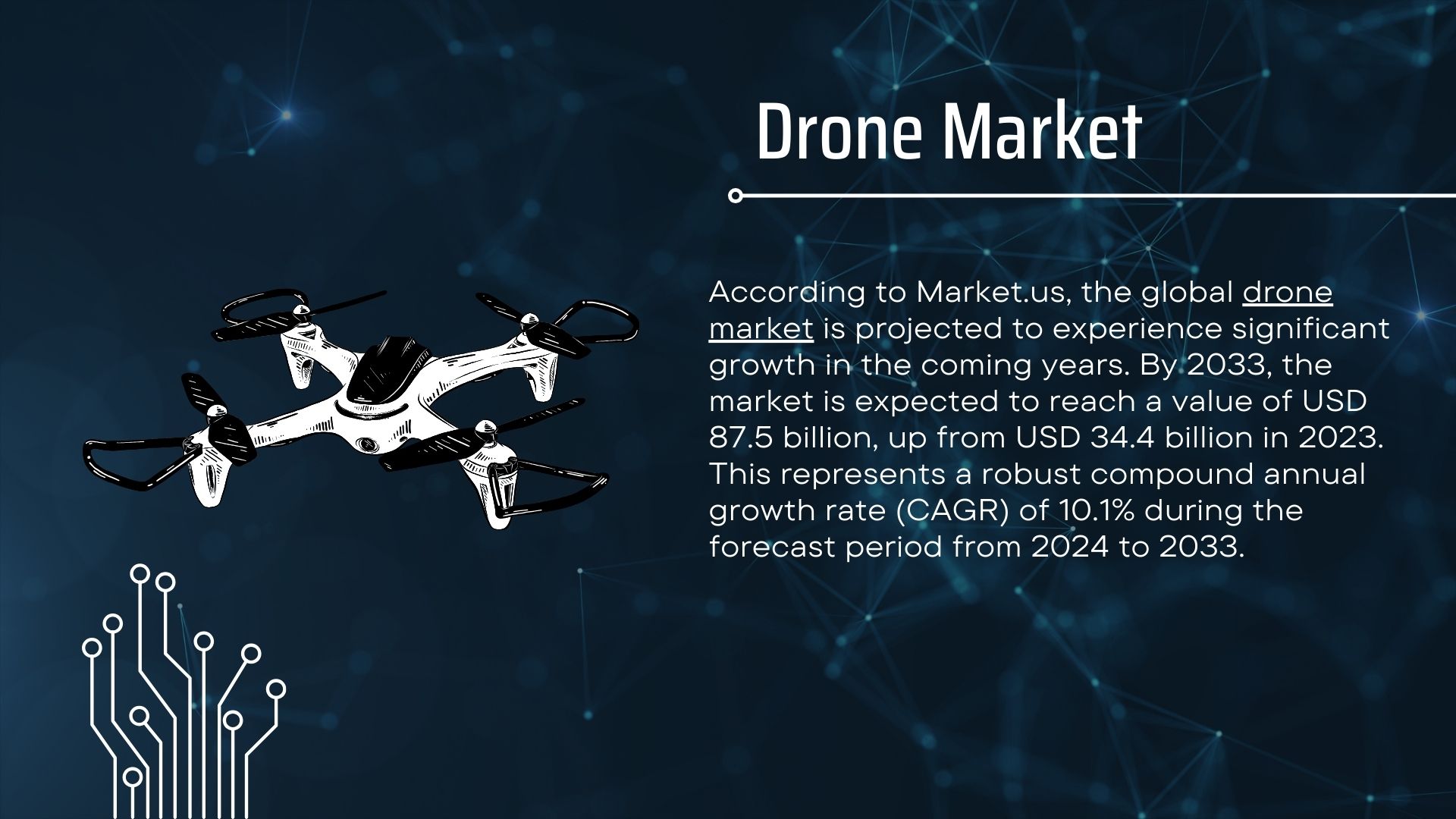WHAT WE HAVE ON THIS PAGE
- Editor’s Choice
- AI Adoption Across Industries
- AI Integration in Service Robotics
- Workforce Impact: Employment in AI-Driven Robotics
- GenAI Adoption by Business Function
- AI in Autonomous Mobile Robots (AMRs) and Drones
- Investment and Funding in AI Robotics Startups
- Robotics Adoption in Agriculture
- AI Algorithm Usage in Robotics: Vision, Navigation, and Control
- Top AI Revenue-Generating Use Cases
- Academic and Research Publication Trends on AI in Robotics
- AI’s Impact on National Productivity
- AI Robotics in Healthcare: Adoption and Efficacy Data
- AI Robots Market Forecast
- Challenges and Limitations Identified Through Recent Data
- Recent Developments
- Conclusion
- Sources
In the bustling corridors of a Tokyo hospital, a robot named “Nami” quietly wheels itself through the hallways, delivering medication to patients. Meanwhile, halfway across the world, agricultural robots in California prune vines with uncanny precision, guided not by human hands but by machine learning algorithms. This isn’t science fiction; this is 2025. AI-powered robotics has moved from experimental labs to real-world deployment, reshaping industries with startling speed. This article dives deep into the numbers behind this transformation, offering a statistical lens on how AI and robotics are converging to redefine modern technology and labor.
Editor’s Choice
- The global AI in robotics market is projected to reach $72.3 billion in 2025.
- Service robots equipped with AI now account for 34% of the total robotics market in 2025.
- The United States leads with 21.7% of global AI robotics patents filed in 2025.
- Asia-Pacific commands the largest market share at 41% in AI-driven robotics development as of 2025.
- Automation-related job displacement is forecasted at 3.4 million globally in 2025, predominantly in manufacturing and logistics.
- Autonomous drones using AI for commercial deliveries increased by 127% YoY, totaling 1.2 million units shipped in 2025.
- Global VC investment in AI robotics startups hit a record high of $13.9 billion in 2025.
AI Adoption Across Industries
- Telecom & Communication service providers lead with 65% AI adoption, showcasing strong integration for automation and customer support.
- Banking & Insurance closely follow at 63%, leveraging AI for fraud detection, risk assessment, and customer experience.
- Oil and Gas see 60% adoption, using AI for predictive maintenance and resource optimization.
- Retail & Consumer Product Goods stand at 54%, applying AI in personalization, inventory management, and sales forecasting.
- Media & Entertainment reaches 53%, driven by content recommendations and audience analytics.
- Healthcare & Life Sciences report 51% AI usage, particularly in diagnostics, drug discovery, and patient care.
- Manufacturing & Hi-Tech register 49%, focusing on process automation, quality control, and robotics.
- Travel, Hospitality & Transportation adopt AI at 48%, using it for dynamic pricing, route optimization, and customer service.
- The Public Sector lags behind with only 34% AI adoption, reflecting slower transformation in government and public services.
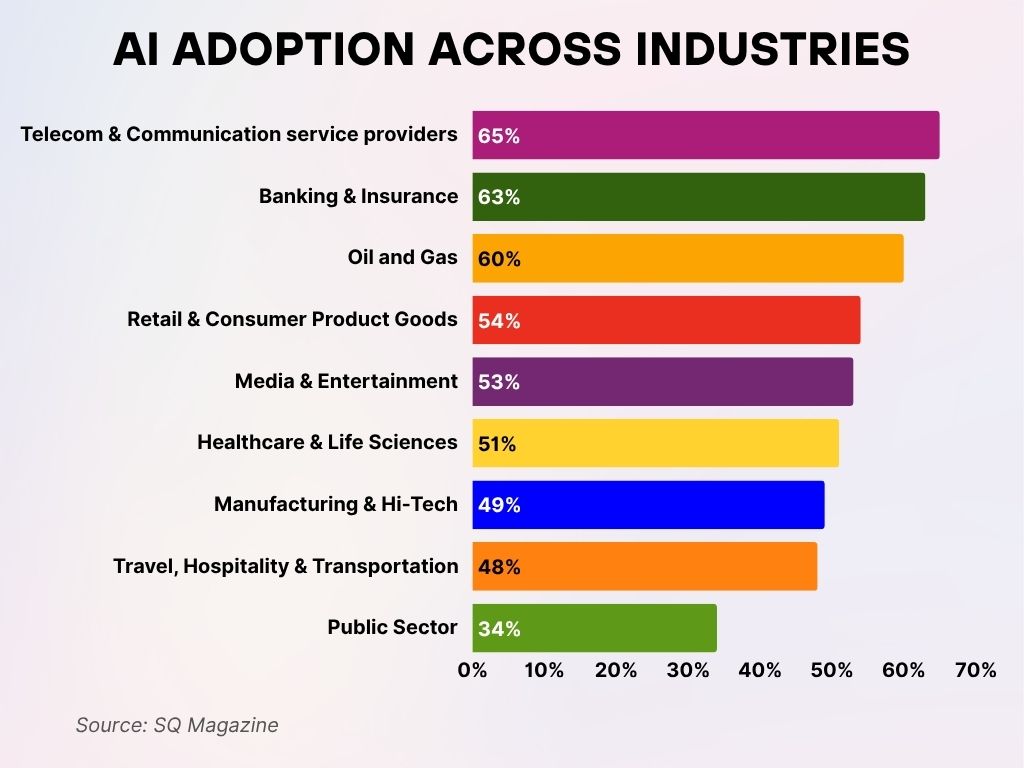
AI Integration in Service Robotics
- As of 2025, over 16 million service robots are actively deployed worldwide, with AI-enabled systems accounting for 57% of them.
- In 2025, hospital robots using AI for diagnostics and logistics increased deployment by 38% compared to 2024.
- Retail robots now contribute to $3.6 billion in global revenue, driven by AI integration for shelf scanning and customer interaction.
- The hospitality industry saw a 24% rise in AI-based robots performing concierge and room service roles in 2025.
- AI-enhanced eldercare robots reached 4.3 million units in 2025.
- AI-powered sanitation robots have been adopted in 58% of major US airports by mid-2025.
- Predictive maintenance algorithms embedded in service robots have reduced operational downtime by 22% in 2025.
Workforce Impact: Employment in AI-Driven Robotics
- By 2025, an estimated 2.6 million jobs will have been created globally in AI-robotics integration, primarily in engineering and software roles.
- Reskilling initiatives in the US related to robotics and AI surged to $2.1 billion in funding by 2025.
- Germany reports that 11% of manufacturing workers now collaborate with AI-powered robotic systems in 2025.
- The global demand for robotics engineers with AI experience rose by 33% in 2025 compared to the prior year.
- Remote robot operators, a new job category driven by AI telepresence, grew by 58% in 2025.
- Unionization efforts around AI-robotic workplace policies affected 16% of US logistics firms by Q2 2025.
- Women now represent 28% of the AI robotics workforce globally in 2025.
- Companies using AI robotics in industrial environments report a 17% reduction in workplace injuries by 2025.
GenAI Adoption by Business Function
- IT leads all functions, with 62% of executives saying GenAI is fully deployed, and only 7% have no plans to use it.
- Marketing shows strong adoption, with 40% fully using GenAI and 46% currently experimenting or piloting it.
- Sales and Customer Service has 39% in full use, while 43% are testing GenAI tools.
- Operations & Supply Chain is more cautious, with 32% in production and a notable 48% still experimenting.
- HR shows 24% fully using GenAI, while a significant 30% report no plans to adopt it.
- R&D/Product Development sees low deployment (23%) and 23% with no intent to use it in the next three years.
- Finance shows only 21% full adoption, with 34% planning future use but not yet started.
- Legal is the most hesitant, with just 11% using GenAI and a high 37% having no plans to use it.

AI in Autonomous Mobile Robots (AMRs) and Drones
- In 2025, the global deployment of Autonomous Mobile Robots (AMRs) reached 2.9 million units, a 22% year-over-year growth.
- Warehouse automation using AMRs now covers 61% of logistics centers in North America as of 2025.
- AI-powered drones used for agricultural monitoring increased to 420,000 units globally in 2025.
- Construction sites employing AI-enhanced drones for 3D mapping and site safety saw usage grow by 31% in 2025.
- AMRs with real-time path planning have reduced human operator intervention by 47% in logistics operations as of 2025.
- Surveillance drones integrated with facial recognition AI surged to 620,000 global units by mid-2025.
- In 2025, AI in drone fleet coordination platforms has enabled multi-agent synchronization in 72% of large-scale deployments.
- Disaster response drones with AI thermal imaging capabilities are now used in 48 countries.
Investment and Funding in AI Robotics Startups
- Global venture capital funding in AI robotics startups peaked at $13.9 billion in 2025.
- The U.S. led all regions with $6.3 billion in AI robotics investments in 2025 alone.
- Seed-stage funding rounds for robotics startups increased by 17% in 2025, reflecting growing early-stage confidence.
- The average Series B funding size in this space rose to $48 million in 2025, a 10% increase from the previous year.
- AI-in-robotics IPO activity surged, with 7 major companies going public in 2025, collectively valued at $18.7 billion.
- Private equity investment in industrial robotics using AI rose to $3.1 billion in 2025, focusing on automation-heavy sectors.
- Corporate innovation arms of firms like Siemens and Amazon accounted for 16% of all funding flows in 2025.
- By 2025, over 320 AI robotics startups will have received institutional backing.
Robotics Adoption in Agriculture
- Precision Agriculture leads the field with an adoption rate of 45%, driven by data-driven farming techniques and sensor-based automation.
- Harvesting and Packing Robots are used by 35% of farms, streamlining labor-intensive post-harvest operations.
- Agricultural Drones follow closely at 30%, supporting crop monitoring, spraying, and yield estimation.
- Fruit and Vegetable Picking robots have reached 25% adoption, helping automate delicate harvesting tasks.
- Milking Robots are used by 20% of agricultural businesses, improving efficiency in dairy farming.
- Autonomous Tractors account for 15%, offering self-driving capabilities for plowing and fieldwork.
- Autonomous Weeding Robots are adopted by 10%, reducing herbicide use through precision weed control.
- Other Agricultural Robots make up 5%, covering specialized or emerging use cases in farming.
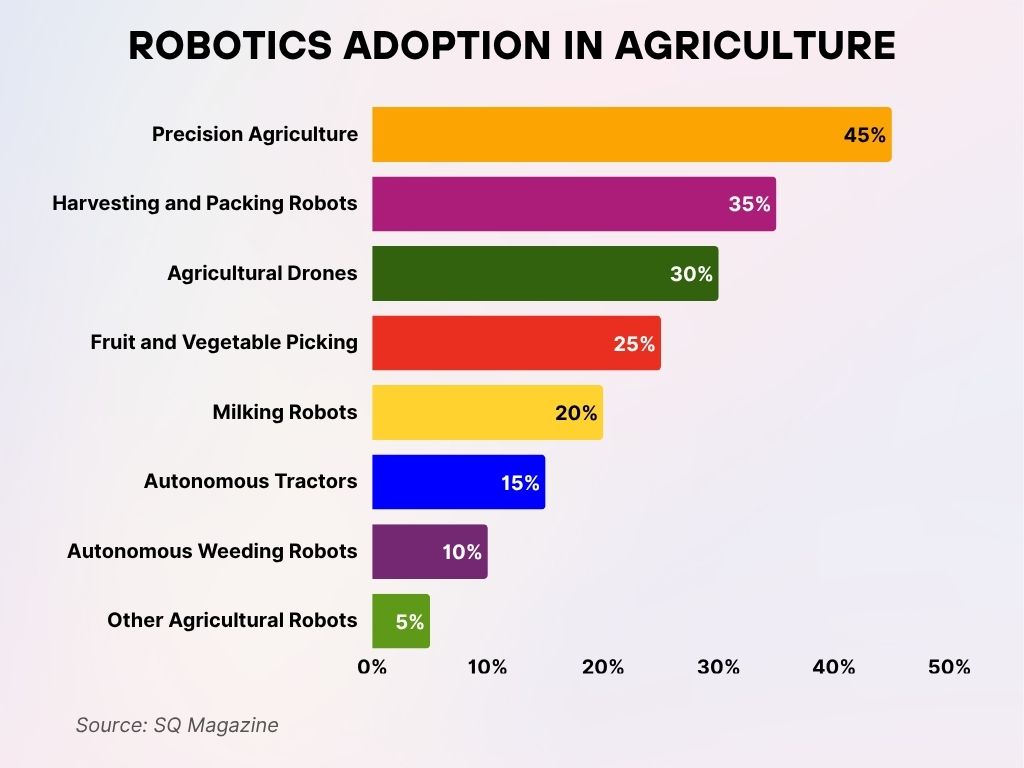
- In 2025, Computer Vision algorithms will be embedded in 79% of service and industrial robots for visual perception tasks.
- Reinforcement learning is now used in 58% of advanced robotic control systems to optimize decision-making.
- Visual SLAM (Simultaneous Localization and Mapping) usage has expanded to 91 countries, with adoption in aerospace and defense sectors.
- Robots with real-time object detection AI now achieve an average accuracy of 94.6% in cluttered environments in 2025.
- Natural language processing (NLP) for human-robot interaction is included in 23% of AI robots in consumer settings in 2025.
- Multi-sensor fusion algorithms (combining LiDAR, cameras, IMUs) improved environmental awareness in 67% of navigation systems this year.
- AI-powered trajectory planning helped cut robotic motion cycle times by 15% in manufacturing workflows as of 2025.
- The deployment of adaptive control AI has allowed robotic arms to handle 22% more object types with minimal reprogramming.
Top AI Revenue-Generating Use Cases
- Static image recognition, classification, and tagging top the chart with forecasted revenue of $8,097.9 million, driven by computer vision advancements.
- Algorithmic trading strategy performance improvement is expected to generate $7,540.5 million, reflecting AI’s growing role in financial markets.
- Processing of patient data using AI is projected to bring in $7,366.4 million, underlining healthcare’s digital transformation.
- Predictive maintenance will contribute $4,680.3 million, especially in manufacturing and heavy industries.
- Object detection and tracking from geospatial images forecasts $4,201.0 million, aiding defense, surveillance, and mapping.
- Text query of images is expected to earn $3,714.1 million, supporting smarter visual search and accessibility tools.
- Automated geophysical feature detection will generate $3,655.5 million, relevant in mining and environmental monitoring.
- Content distribution on social media will drive $3,566.6 million, influenced by recommendation algorithms and audience targeting.
- Object detection for avoidance and navigation forecasts $3,169.8 million, important for autonomous vehicles and drones.
- Cybersecurity threat prevention rounds out the list with $2,472.6 million, showing AI’s vital role in digital defense.
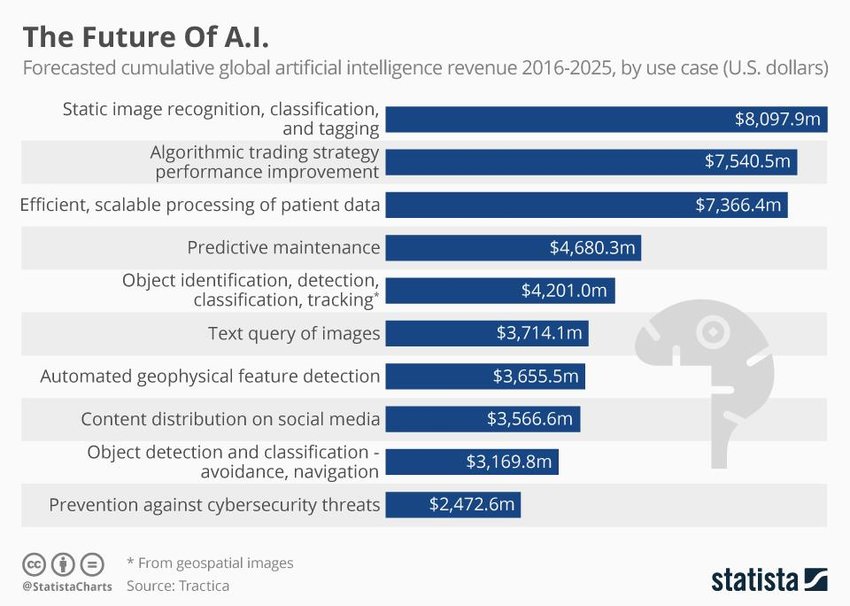
Academic and Research Publication Trends on AI in Robotics
- In 2025, over 11,300 academic papers were published globally on AI in robotics.
- IEEE Xplore hosted 3,900 AI-robotics publications in 2025, marking it the most popular journal source in the field.
- MIT and Carnegie Mellon led research citations in 2025, with over 2,000 citations each for their AI robotics studies.
- AI in humanoid robotics became the fastest-growing subfield, with publications increasing by 27% year over year.
- China accounted for 26% of all peer-reviewed research output on AI-powered robotics globally in 2025.
- Open-source datasets for robotics AI doubled in volume, reaching 142 terabytes publicly accessible in 2025.
- AI ethics in robotics saw a 36% increase in scholarly focus, particularly around autonomous decision-making frameworks.
- University-private sector collaborations produced 410 co-authored papers in 2025.
AI’s Impact on National Productivity
- Sweden is projected to see the highest productivity increase from AI by 2035, at 37%, reflecting strong tech adoption.
- The United States follows closely with a projected 35% boost in productivity due to AI-driven innovations.
- Japan anticipates a 34% increase, highlighting its emphasis on robotics and industrial automation.
- Austria is expected to gain a 30% productivity improvement, benefiting from AI integration across sectors.
- Germany projects a 29% rise in productivity, driven by advancements in smart manufacturing.
- The United Kingdom is forecasted to see a 25% increase, fueled by AI in finance, healthcare, and logistics.
- France shows a 20% productivity boost potential from AI technologies.
- Spain ranks lowest on the list, with only an 11% projected productivity increase from AI adoption by 2035.
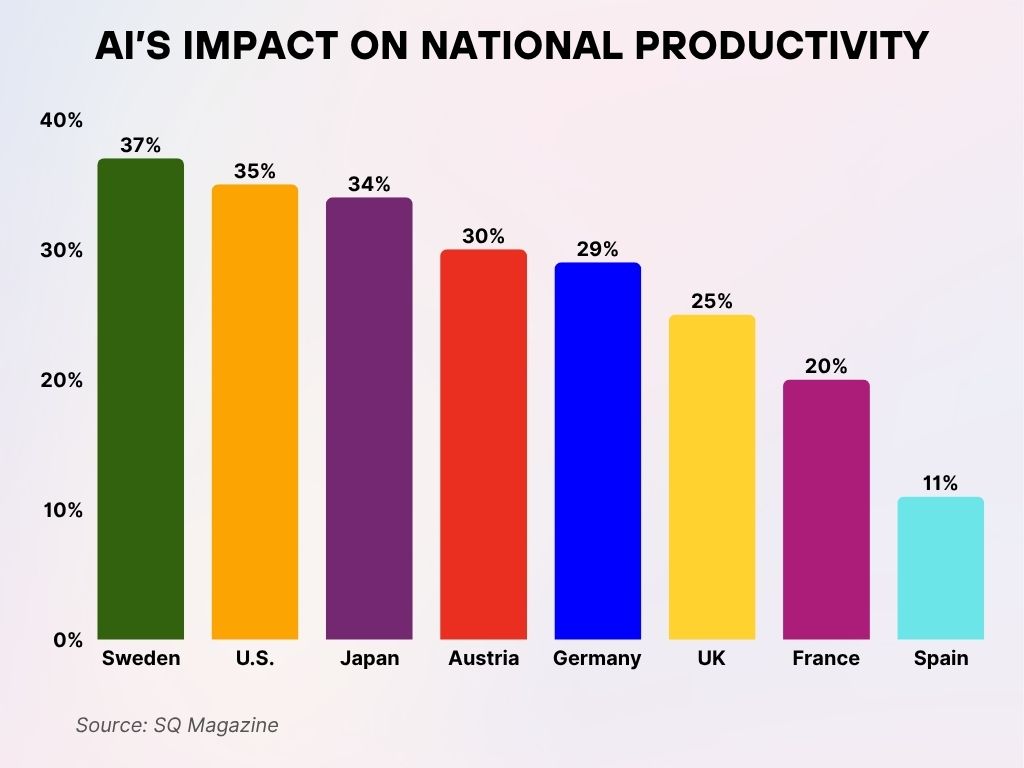
AI Robotics in Healthcare: Adoption and Efficacy Data
- As of 2025, AI-powered surgical robots have been deployed in 7,800 hospitals worldwide.
- The robotic-assisted surgery market, driven by AI, is now valued at $13.2 billion globally.
- AI diagnostic robots are achieving an average accuracy of 91.8%, outperforming traditional diagnostic methods by 11.3%.
- Rehabilitation robots with AI monitoring are used in 68% of US physical therapy clinics as of 2025.
- Hospital logistics robots, delivering meds and supplies autonomously, are active in 52% of large hospitals globally in 2025.
- AI chatbots and robot nurses now manage 19% of non-critical patient inquiries in US healthcare centers.
- In 2025, the use of AI-enabled robots reduced average patient wait times in outpatient departments by 18.4%.
- Elderly care facilities employing AI robots for companionship and monitoring reached 620,000 units globally in 2025.
AI Robots Market Forecast
- The AI robots market is projected to grow from $14.45 billion in 2024 to $33.6 billion by 2029.
- In 2025, the market is expected to reach $17.39 billion, signaling rapid early-stage adoption.
- The market is forecasted to grow at a CAGR of 17.9%, reflecting strong global investment and demand for intelligent automation.
This near-doubling of market size in five years highlights AI robots’ expanding role across industries like manufacturing, healthcare, and logistics.
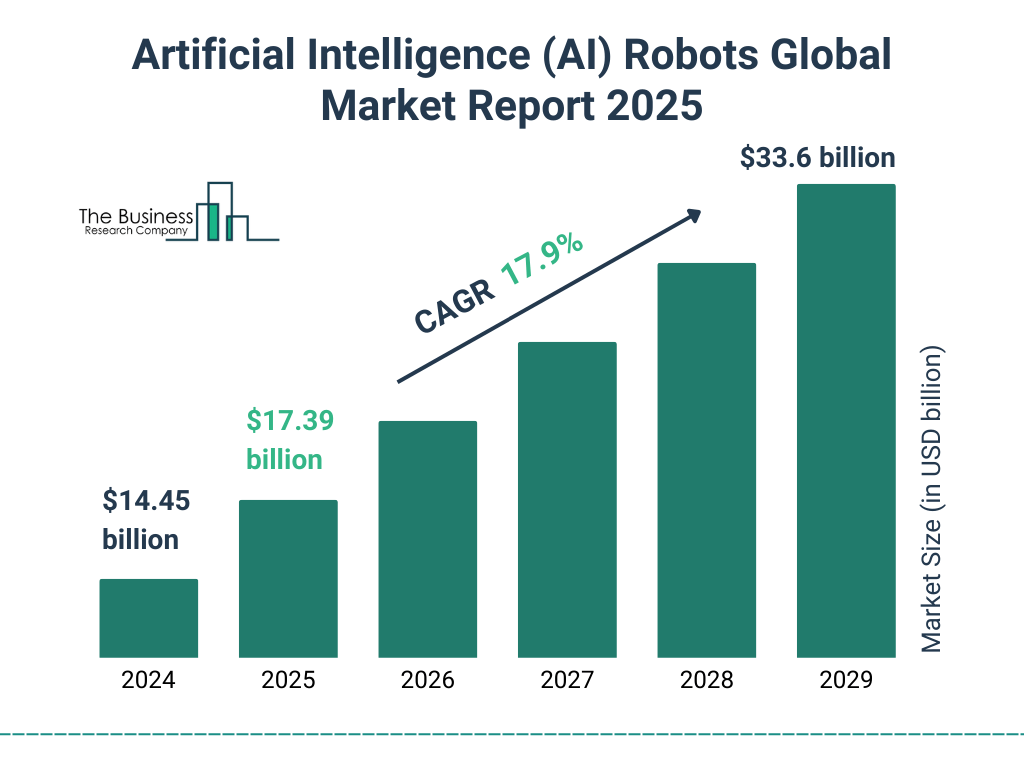
Challenges and Limitations Identified Through Recent Data
- In 2025, 28% of AI robotics firms reported facing regulatory delays during deployment phases.
- Privacy concerns over facial recognition in public-service robots were cited by 61% of surveyed users globally.
- Power consumption of AI-integrated robots rose by 13.7% on average in 2025, raising sustainability challenges.
- Bias in AI algorithms, especially in public-facing robots, triggered ethical reviews in 17 countries this year.
- Hardware interoperability issues affected 36% of robotics manufacturers integrating third-party AI models.
- Latency in real-time decision-making still limits the deployment of AI robotics in high-stakes environments, like surgery or defense.
- In 2025, cost overruns on AI robotics projects averaged 19% above original estimates, primarily due to unplanned algorithm refinements.
- Cybersecurity incidents involving AI-controlled robots were reported in 11% of industrial facilities globally.
Recent Developments
- In early 2025, Boston Dynamics launched its latest AI-powered humanoid robot capable of real-time multi-tasking and emotional recognition.
- NVIDIA released a new edge-AI chip designed for robotics, boosting inference speed by 3.2x compared to 2024 models.
- Tesla’s Optimus Gen 3 robotic platform entered manufacturing, featuring fully AI-powered autonomous task learning.
- SoftBank Robotics announced a collaboration with the Mayo Clinic to pilot AI diagnostic assistants across 15 hospitals.
- A global robotics consortium was formed in 2025, including over 40 nations, to standardize AI safety protocols in robotics.
- Amazon Robotics deployed over 750,000 AI robots in its fulfillment network, cutting fulfillment times by 24%.
- Google DeepMind launched GRACE, an AI framework for collaborative multi-robot learning in real-world scenarios.
Conclusion
AI and robotics are no longer parallel tracks; in 2025, they are intrinsically fused, pushing boundaries across healthcare, logistics, manufacturing, and everyday life. While opportunities abound, from surgical precision to warehouse efficiency, so do challenges, from regulatory hesitations to ethical implications. What remains clear is the exponential trajectory of AI-enhanced robotics: smarter systems, faster adoption, deeper integration. The data reveals more than progress; it captures a paradigm shift in how humans and machines co-operate, co-exist, and co-evolve.
Sources
- https://www.statista.com/outlook/tmo/artificial-intelligence/ai-robotics/worldwide
- https://www.statista.com/topics/12343/artificial-intelligence-ai-and-robotics/
- https://www.thebusinessresearchcompany.com/report/artificial-intelligence-ai-robots-global-market-report
- https://www.globenewswire.com/news-release/2025/03/31/3052034/28124/en/Future-of-the-Robotics-Markets-2025-2030-AI-Driven-Robotics-Revolutionizing-Automation-Across-Industries-with-Smarter-Adaptive-Systems.html
- https://www.pewresearch.org/internet/2014/08/06/predictions-for-the-state-of-ai-and-robotics-in-2025/
- https://www.linkedin.com/pulse/ai-robotics-breakthrough-innovations-reshaping-march-2025-reyzelman-iy6je
- https://www.cogitotech.com/blog/ai-in-robotics-a-comprehensive-guide-2025/









